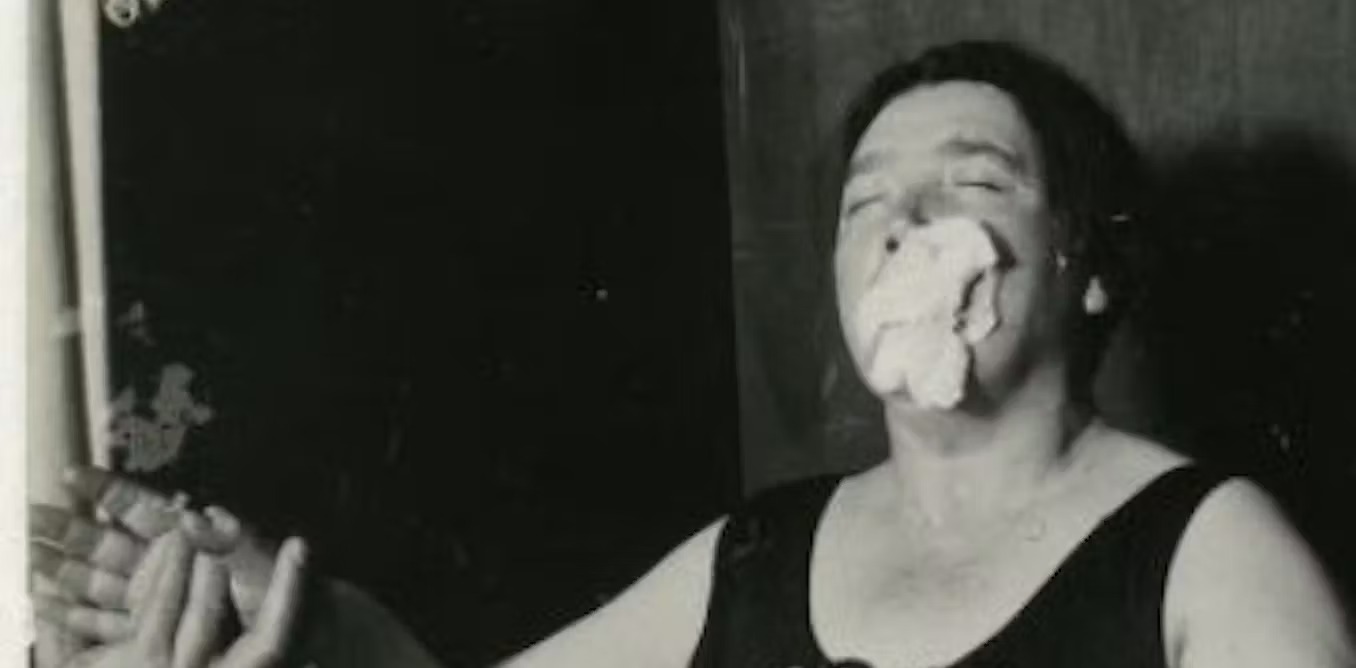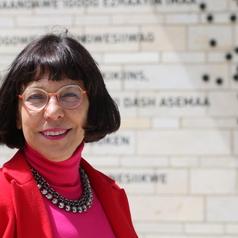In July 1923, the British author Arthur Conan Doyle arrived in Winnipeg to give a public lecture, “The Proofs of Immortality,” as part of a 40-city North American tour that attracted sizable audiences.
Doyle, widely known today as the writer who created Sherlock Holmes, was also a spiritualist — part of circles of people who adhered to and investigated the religious belief that souls of the dead can interact with living people.
On Doyle’s first night in Winnipeg, he and his wife Jean Leckie Doyle were invited to sit in on an investigative seance led by physician Thomas Glendenning Hamilton and his wife and collaborator Lillian Hamilton, a trained nurse.
In Dr. Hamilton’s darkened seance chamber, as Doyle would later write, he experienced a luminous table fly into the air.
Today, Hamilton’s legacy includes an uncanny trove of photographs related to his investigations of paranormal materializations.
A new scholarly collection of essays and an art exhibit, The Undead Archive: 100 Years of Photographing Ghosts, at the University of Winnipeg use an art historical lens to contextualize these uncanny photographs.
The ‘psychic force’
Doyle recounted how the table clattered again and again entirely on its own, with no sitter touching it. One moment, it was quiet. Then:
The Hamiltons and the Doyles agreed the table was moved by an invisible force, the psychic force, and that it was a message from a discarnate (disembodied) personality who survived death.
Psychic force, as some scientists believed, would extrude from the body of the medium and manifest as a organic plasm known as ectoplasm, through which spirits could communicate.
Doyle kept abreast of the Hamiltons’ research. According to the Hamiltons and Jean Leckie Doyle, he even manifested as a “transcendental personality,” two years after he died, materializing in the fluffy ectoplasm in a photograph Hamilton took in 1932.
Expression of bereavement
It was not uncommon after the losses of the First World War and the 1919 influenza pandemic for North Americans to participate in seances and dabble in spiritualism as an expression of bereavement, as historians Felicity Hamer and Esyllt Jones have outlined.
Interestingly, Hamilton rejected the popular religion of spiritualism, critiquing it as a cult. He presented his investigations as scientific, and stressed his mastery of photographic technology.
Between 1923 and 1935, with an elaborate set of cameras and lenses, Hamilton set out to capture the “psychic force” on glass plates in his laboratory.
He published hundreds of photographs of tables turning and ectoplasmic extrusions of cellular plasm from the body of the female mediums.
It was tricky to photograph the light-sensitive ectoplasm, and Hamilton’s cropped shots of the mediums surrounded by organically shaped material increased his status as a researcher.
Inspired ‘Ghostbusters’
Hamilton’s images were exhibited and widely distributed. They were also praised by researchers, including two who got into a famous public argument with the magician Houdini after claiming to debunk his magic, and Samuel Aykroyd, actor Dan Aykroyd’s great-grandfather. The younger Aykroyd’s 1984 blockbuster Ghostbusters brought ectoplasm into popular culture.
Between the world wars, some scientists were open to the notion of invisible forces (also known as the psychic force, or the vital force) and they relied on outdated scientific theories, including “the etheric universe” and “vitalism” to support their research.
Hamilton’s images had a second wave of international recognition after they were digitized in 2001 at the University of Manitoba Archives and Special Collections and were discovered online by artists intrigued by the grotesque aesthetics of the bodily excretions.
‘Undead Archive’ exhibit
Hamilton was aware of the abject nature of his photos and described them as “monstrously extraordinary.”
But he also saw ectoplasm as a vital moulding material able to create endless forms and shapes.
The exhibit, The Undead Archive: 100 Years of Photographing Ghosts, at the University of Winnipeg’s Gallery 1C03, and the University of Manitoba’s School of Art and Archives and Special Collections, similarly focuses on artistic interpretations of this mysterious substance.
The exhibition, which I curated, features 25 contemporary artists responding to ectoplasm and the Hamilton photographs.
Works include stop-motion videos of ectoplasm morphing into recognizable shapes: one by Shannon Taggart and one by Grace Williams. Williams animated an old photo of ectoplasm being expelled, while Taggart stitched together still shots of a contemporary medium (Kai Muegge) extruding ectoplasm in 2018.
‘Spiritual Ectoplasm’ (2011) by Grace Williams.
Hamilton was never able to film ectoplasm because of the low light conditions of the seance chamber, and so these videos give us the opportunity to sense the theatrics and the intrigue of the early 20th-century seance.
Unseen, suppressed spiritual work
Some artists put themselves in the role of the mediums, mimicking the body language of the trance state. Erika DeFreitas uses crocheted doilies instead of ectoplasm, calling attention to unseen labour mediums carried out to support psychical researchers.
KC Adams, an Anishinaabe, Ininew and British artist living in Manitoba researched and created a virtual reality artwork for the exhibition that examines Ininew burial rituals suppressed under the Indian Act.
Pandemics and forgetting
In The Art of Ectoplasm, Jones writes that it was only in March 2020, with COVID-19, that our society thought about the 1918-19 influenza pandemic.
In Contagion, Teresa Burrows creates a shrine-like installation of Dr. Theresa Tam, Canada’s Chief Public Health Officer, using a rapid antigen test to frame this.
In Burrows’s image, Tam looks upwards, as if in a trance, and is surrounded by green beads imitating the COVID-19 virus. In the early days of the pandemic, Dr. Tam was constantly on national TV and social media, like a diviner laying out warnings.
Winnipeg as ‘psychic centre’
One hundred years ago, as Winnipeggers were coming out of the 1919-20 influenza pandemic, Doyle offered what seemed to be evidence of life continuing after death.
After sitting with the Hamiltons in their seance laboratory, in a July 5, 1923 letter to Lillian Hamilton, Doyle described Winnipeg as a “psychic centre,” in many ways divining Winnipeg’s loss of status as “Chicago of the North,” offering an alternative moniker.
The idea of Winnipeg as a supernatural place has been taken up by artists and authors, exemplified by filmmaker Guy Maddin’s My Winnipeg, as well as the exhibition art, much of it created during COVID-19 lockdowns.
As we emerge from our pandemic, it is interesting to think back on Hamilton’s post-pandemic experimental seances and wonder: What form might our grieving take?



 Trump Faces Mixed Reception at Kennedy Center Amid Conservative Overhaul
Trump Faces Mixed Reception at Kennedy Center Amid Conservative Overhaul  Gulf Sovereign Funds Unite in Paramount–Skydance Bid for Warner Bros Discovery
Gulf Sovereign Funds Unite in Paramount–Skydance Bid for Warner Bros Discovery  Disney’s ABC Pulls Jimmy Kimmel Live! After Controversial Remarks on Charlie Kirk Killing
Disney’s ABC Pulls Jimmy Kimmel Live! After Controversial Remarks on Charlie Kirk Killing  Trump–Kushner Links Raise Concerns as Paramount Pushes $108B Warner Bros Discovery Bid
Trump–Kushner Links Raise Concerns as Paramount Pushes $108B Warner Bros Discovery Bid  Disney’s Streaming Growth Hinges on International Expansion and Local Content
Disney’s Streaming Growth Hinges on International Expansion and Local Content  Trump Signals He May Influence Netflix–Warner Bros Merger Decision
Trump Signals He May Influence Netflix–Warner Bros Merger Decision  Trump to Pardon Reality Stars Todd and Julie Chrisley After Tax Fraud Conviction
Trump to Pardon Reality Stars Todd and Julie Chrisley After Tax Fraud Conviction  The Mona Lisa is a vampire
The Mona Lisa is a vampire  Paramount’s $108.4B Hostile Bid for Warner Bros Discovery Signals Major Shift in Hollywood
Paramount’s $108.4B Hostile Bid for Warner Bros Discovery Signals Major Shift in Hollywood  The quest to extend human life is both fascinating and fraught with moral peril
The quest to extend human life is both fascinating and fraught with moral peril  Trump-Inspired Cantonese Opera Brings Laughter and Political Satire to Hong Kong
Trump-Inspired Cantonese Opera Brings Laughter and Political Satire to Hong Kong  Mexico Probes Miss Universe President Raul Rocha Over Alleged Criminal Links
Mexico Probes Miss Universe President Raul Rocha Over Alleged Criminal Links  Netflix Shuts Down Boss Fight Entertainment, Developer of “Squid Game: Unleashed” Amid Gaming Strategy Shift
Netflix Shuts Down Boss Fight Entertainment, Developer of “Squid Game: Unleashed” Amid Gaming Strategy Shift  FCC Chair Brendan Carr to Face Senate Oversight After Controversy Over Jimmy Kimmel Show
FCC Chair Brendan Carr to Face Senate Oversight After Controversy Over Jimmy Kimmel Show  FCC Chair Brendan Carr to Testify Before Senate Commerce Committee Amid Disney-ABC Controversy
FCC Chair Brendan Carr to Testify Before Senate Commerce Committee Amid Disney-ABC Controversy 
































